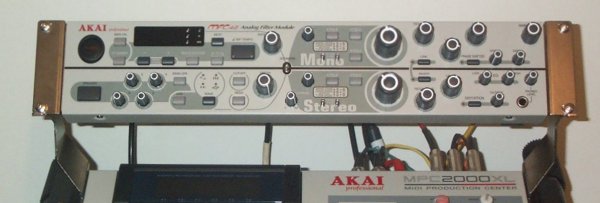
Some ramblings on the MFC42.
Now that I've had the MFC42 for a couple days, I managed to get some words out about it:
The MFC was designed to go with the MPC, but you can use it with any audio source. If you buy the rack kit you get instructions and a cable snake to connect the MFC to the MPC by midi, stereo outs to stereo in and MPC out1 to MFC mono input (for basses and such).
Installing the mounting brackets was pretty easy. The top of the brackets is actually cut as 2 rack space connectors, so if you are not interested in the MFC you could use just the rack kit to hold 2 effects processors or another 2U box. You might be able to get a 1U and 2U boxes on there at the same time.
Operation is very easy and unlike any of the other similar units the MFC actually has a Local Off mode for you do overdub knob movements into the sequencer so you do not get a nasty midi loop. The MFC can also send a midi snapshot of the knob settings right from the front panel so you can store a starting point into a sequencer (just like patch storage).
The is a common modulation section for the 2 filters, so you can only select mono OR stereo for the destination. There is an LFO (midi clock syncable) or an envelope generator complete with ADSR controls. The envelope can be triggered manually or by midi clock (every 16th up to 2 bars). The LFO or EG can be routed to cutoff and/or resonance and there is a Depth control to determine how much modulation you want. The Depth control is bi-directional, so you can make the effect positive or negative. For example, using the EG to affect filter cutoff with a positive Depth, then switching the Depth to the negative inverts the envelope. Pretty nifty.
In the MF there are actually three 2 pole filters. The filter are shared between the mono and stereo, so you are limited to particular combinations of filters. If you use the mono 8-pole filter, it will disengage the stereo side since it needs all three filters to accomplish this. Speaking if which that 8-pole filter is very severe. Every filter self resonates. Just with the MFC alone I was able to get very crazy bleeps and bloops, particularly when I was using the EG to control the filter/resonance.
Each filter has an input level control and output level. After the output level controls the 2 filters share a common section consisting of the phaser, distortion, 2 band EQ and a main output level. The phaser was very nice complete with engage, speed (not midi syncable) and depth. The distortion has an on/off and a level. I find the distortion of the MFC much better than the one on the Filter Factory. The MFC's distortion was a lot grittier and added a lot in the low end. The filter Factory sounds a bit buzzier with more of a higher frequency content.
Like the Filter Factory, the MFC has an onboard power supply and uses a standard power. The MFC's power switch is located on the front and the FF's is on the back. The MFC has a headphone jack on the front complete with a level control that is independent of the master out volume.
Another trick of the filters is you can link the cutoff of both filters and use just one cutoff knob to control the cutoff freq of both filters at the same time and you can engage an additional invert button which will cause the other filter's cutoff to change in the opposite direction as you move a single knob. Using the linked invert function reminded me of a DJ cross-fader, but crossfades across frequencies as opposed to volume.
I didn't have mine at home an hour before I had it opened up and taking a peek at the components. No fewer than 5 circuit boards packed in there. Why? The only surface mounted components I found were a few small IC's. The rest of the components were your usual through-the-PCB mount. This takes up a lot more room. (BTW, the Electrix is ALL surface mounted components).
So how does the MFC compare to the Electrix Fitler Factory?
What might be better about the FF (just to be fair and balanced):
